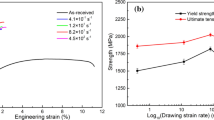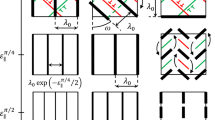Abstract
Cold-drawn prestressing steel wires exhibit strength anisotropy in the form of fracture path deflection towards a direction approaching the wire axis, or cold drawing line, as a consequence of the pearlitic microstructure orientation induced by the manufacturing procedure. Such a crack path deflection is initiated at certain nuclei (fracture origins) at which axial cracking appears in the cold drawing direction (or wire axis) in the form of micro-cleavage units producing a macroscopic phenomenon of pop-in in the load–displacement curve. This chapter shows that such fracture initiators appear at a certain distance from the fatigue pre-crack tip at which a local maximum of the cleavage stress is located.
Access this chapter
Tax calculation will be finalised at checkout
Purchases are for personal use only
Similar content being viewed by others
References
Alexander, D., Bernstein, I.: The cleavage plane of pearlite. Metall. Mater. Trans. 13A, 1865–1868 (1982)
Astiz, M.A., Valiente, A., Elices, M., Bui, H.D.: Anisotropic fracture behaviour of prestressing steels. In: Life assessment of dynamically loaded materials and structures—ECF5 (ed.) Faria LO, pp. 385--396. EMAS, Lisbon, Portugal (1985)
Fernández-Vicente, A., Carsí, M., Peñalba, F., Taleff, E., Ruano, O.A.: Toughness dependence on the microstructural parameters for an ultrahigh carbon steel (1.3 wt% C). Mater. Sci. Eng. A335, 175–185 (2002)
Miller, L.E., Smith, G.C.: Tensile fracture in carbon steels. J. Iron Steel Inst. 208(11), 998–1005 (1970)
Park, Y., Bernstein, I.: The process of crack initiation and effective grain size for cleavage fracture in pearlitic eutectoid steel. Metall. Mater. Trans. 10A, 1653–1664 (1979)
Rosenfield, A.R., Majumdar, B.S.: Micromechanisms and toughness for cleavage fracture of steel. Nucl. Eng. Des. 105, 51–57 (1987)
Singh, U.P., Banerjee, S.: On the origin of pop-in crack extension. Acta. Metall. Mater. 39, 1073–1084 (1991)
Toribio, J., Ovejero, E.: Microstructure evolution in a pearlitic steel subjected to progressive plastic deformation. Mater. Sci. Eng. A234--236, 579–582 (1997)
Toribio, J., Ovejero, E.: Microstructure orientation in a pearlitic steel subjected to progressive plastic deformation. J. Mater. Sci. Lett. 17, 1045–1048 (1998)
Toribio, J., Ovejero, E.: Effect of cumulative cold drawing on the pearlite interlamellar spacing in eutectoid steel. Scripta Mater. 39, 323–328 (1998)
Toribio, J., Ovejero, E.: Effect of cold drawing on microstructure and corrosion performance of high-strength steel. Mech. Time-Depend. Mater. 1, 307–319 (1998)
Toribio, J., Ovejero, E., Toledano, M.: Microstructural bases of anisotropic fracture behaviour of heavily drawn steel. Int. J. Fract. 87, L83–L88 (1997)
Toribio, J., Valiente, A.: Approximate evaluation of directional toughness in heavily drawn pearlitic steels. Mater. Lett. 58, 3514–3517 (2004)
Toribio, J., Valiente, A.: Failure analysis of cold drawn eutectoid steel wires for prestressed concrete. Eng. Fail. Anal. 13, 301–311 (2006)
Acknowledgments
The authors wish to acknowledge the financial support provided by the following Spanish Institutions: Ministry for Science and Technology (MCYT; Grant MAT2002-01831), Ministry for Education and Science (MEC; Grant BIA2005-08965), Ministry for Science and Innovation (MICINN; Grant BIA2008-06810), Junta de Castilla y León (JCyL; Grants SA067A05, SA111A07 and SA039A08), and the steel supplied by EMESA TREFILERÍA.
Author information
Authors and Affiliations
Corresponding author
Editor information
Editors and Affiliations
Rights and permissions
Copyright information
© 2012 Springer-Verlag Berlin Heidelberg
About this chapter
Cite this chapter
Toribio, J., González, B., Matos, JC. (2012). Strength Anisotropy in Prestressing Steel Wires. In: Öchsner, A., da Silva, L., Altenbach, H. (eds) Materials with Complex Behaviour II. Advanced Structured Materials, vol 16. Springer, Berlin, Heidelberg. https://doi.org/10.1007/978-3-642-22700-4_15
Download citation
DOI: https://doi.org/10.1007/978-3-642-22700-4_15
Published:
Publisher Name: Springer, Berlin, Heidelberg
Print ISBN: 978-3-642-22699-1
Online ISBN: 978-3-642-22700-4
eBook Packages: Chemistry and Materials ScienceChemistry and Material Science (R0)




